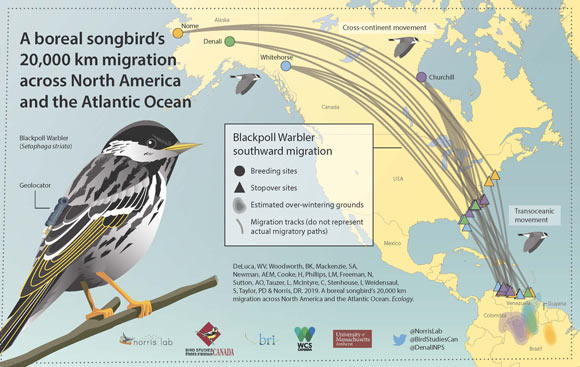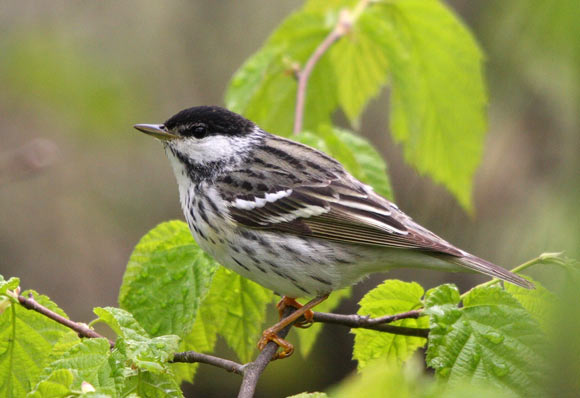Blackpoll warblers (Setophaga striata) that breed in western North America migrate up to 12,400 miles (20,000 km) roundtrip each year, some crossing the entire North American continent before making a nonstop trans-ocean flight of up to four days to South America. A new study, published in the journal Ecology, confirms the epic migration journey that ornithologists had long suspected but not yet proved.
In 2015, University of Guelph biologist Ryan Norris and colleagues were the first to show that 12-g blackpoll warblers breeding in the Maritimes and New England complete a non-stop transoceanic flight of up to three days and 1,721 miles (2,770 km) along the eastern coast of the United States.
For the new study, the team looked at the full migration of birds from central and western breeding populations.
“It’s amazing. A bird weighing a couple of loonies travels from the western edge of North America all the way to the Amazon basin — and, in between, traverses the Atlantic Ocean,” Dr. Norris said.
For the study, Dr. Norris and co-authors tracked birds outfitted with tiny geolocators, weighing 0.5 g and with a 12-month battery life, from four boreal forest sites: Churchill, Manitoba; Whitehorse, Yukon Territory; Denali National Park and Nome, both in Alaska.
Total southward migration took about 60 days on average over distances ranging from 4,287 miles (6,900 km) for birds breeding in Churchill to 6,650 miles (10,700 km) for populations on the western edge of the continent in Nome.
Blackpoll warblers from Nome took 18 days to fly across North America to the Atlantic coast of the Carolinas.
There, the birds spent almost a month fattening up to double their body weight before a non-stop, 2.5-day flight across open water to overwintering grounds in northern Colombia, Venezuela and Brazil. They covered between 1,400 miles (2,250 km) and 2,113 miles (3,400 km) for that transoceanic hop.

DeLuca et al deployed tiny geolocation devices with a 12-month battery life on male blackpoll warblers at four locations: Churchill, Manitoba; Whitehorse, Yukon Territory; Denali National Park and Nome, both in Alaska. Image credit: UMass Amherst / University of Guelph.
“It was fascinating to witness the schedule of this migration. Birds that bred further west had to depart the breeding and wintering grounds much earlier in order to arrive at their destinations on time,” said study first author Dr. Bill DeLuca, a biologist at the University of Massachusetts Amherst.
“We had long believed that blackpoll warblers followed the great circle route. Few of the birds have ever been found in the central or western States during fall migration,” Dr. Norris said.
“Population numbers have fallen in recent years, perhaps caused by habitat loss and declines in insect prey related to climate change.”
“To understand what’s causing the decline, we need to know their full annual cycle.”
“Acquiring a better understanding of the full annual cycle for blackpoll warblers is critically important to ecologists,” Dr. DeLuca added.
“Not only is it one of the fastest declining songbirds in North America, but it’s also one we probably know least about.”
“The data collected in this new study helps fill in the migratory network of the species,” said study co-author Stuart McKenzie, from Bird Studies Canada.
“As a conservation scientist, what strikes me most is that in a single year a blackpoll warbler has to navigate 12,400 miles across land and ocean, facing risks of cat predation, storms and collisions with buildings and vehicles, all while trying to find islands of habitat to rest and refuel in our human-dominated landscapes,” said study co-author Dr. Hilary Cooke, a conservation scientist with Wildlife Conservation Society Canada.
“In comparison, the boreal region of northern Canada provides safe and high-quality breeding habitat for this declining species. Protecting Canada’s boreal forest is critical to saving this amazing songbird.”
_____
William V. DeLuca et al. A boreal songbird’s 20,000 km migration across North America and the Atlantic Ocean. Ecology, published online March 19, 2019; doi: 10.1002/ecy.2651








